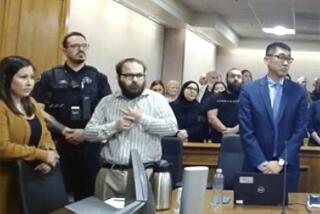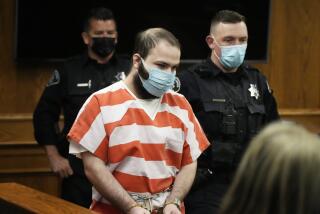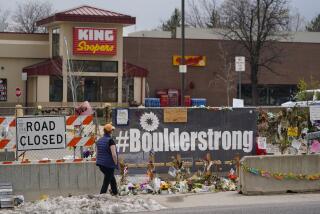Colorado police officers testify about theater shooting
CENTENNIAL, Colo. — Two veteran police officers who were first to arrive at the Aurora movie theater shooting struggled in court Monday to describe the carnage. Strobe lights from the alarm were flashing as the midnight showing of “The Dark Knight Rises” blared on the screen above the screams. Some movie-goers were trying to flee. Others lay motionless on the floor.
But what they remembered most was the blood. There was so much of it.
Aurora Police Officer Justin Grizzle said some people were crawling for safety covered in blood. With a wavering voice he said he slipped on something slick as he made his way into the theater, only later realizing it was blood.
The officers described victims who were shot in the face. Some of the wounded were so badly hurt it was impossible to tell their gender.
Grizzle recounted how he loaded victims in his patrol car and sped them to the hospital because it was faster than waiting for an ambulance. After several trips there was so much blood in his car he could hear it slosh as he sped around corners.
Grizzle and Sgt. Gerald Jonsgaard testified on the opening day of a preliminary hearing to determine whether James E. Holmes will stand trial in the July 20 rampage that killed 12 people and wounded at least 70 others.
The testimony was the first time police witnesses have publicly disclosed details of the shooting and how they responded.
Holmes sat still in court Monday and did not react. As each witness concluded, prosecutors had them point to the man they saw outside the theater. They added, though, that Holmes’ appearance had changed. His dyed orange hair is now brown and he wears a full beard.
Chief Judge William B. Sylvester of Colorado’s 18th Judicial District is presiding over the case, which has attracted worldwide interest.
Some family members in the courtroom hugged one another as the testimony unfolded. Others stared coldly at Holmes, possibly trying to catch his eye.
The hearing was mostly a prosecution exercise. The defense offered some cross-examination but did not challenge the accounts. Holmes’ public defenders are widely expected to offer an insanity defense. He has not entered a plea.
At times, the officers broke down on the stand.
Jonsgaard said he was about 10 blocks from the Century 16 when he got the first call about 12:39 a.m. of shots fired at the theater, and then a quick second call that someone was still inside shooting. When he arrived, he saw that fellow officers had a suspect in custody — a man he at first thought was a SWAT team member wearing body armor and a gas mask. Jonsgaard then entered Theater 9.
Many people were wounded and trying to flee or being dragged out to a makeshift triage center in the parking lot.
Jonsgaard said he was handed a little girl who had been shot. He checked for a pulse and found none. Later he discovered the girl was 6-year-old Veronica Moser-Sullivan, the youngest victim, who was pronounced dead at a hospital. Jonsgaard struggled for composure as he spoke.
Grizzle said he rushed a gravely wounded woman, shot in the face and the chest, to the hospital. A man, also shot, was in his front seat yelling: “That’s my wife. Is my wife going to live?”
The man begged Grizzle to turn back to the theater to find out what had happened to the injured woman’s little girl. More than once Grizzle said he had to restrain the man from leaping out of the speeding car. Only later did the officer learn the wounded woman in his back seat was Veronica’s mother. The couple survived but the mother, Ashley Moser, is partly paralyzed.
Det. Todd Fredericksen described how one woman told him during a hospital interview that she felt a burning sensation on her side as she was shot trying to escape. When she looked down, she saw her internal organs spilling out and “she caught them.” She survived.
Grizzle also told of rushing Caleb Medley to the hospital after he had been shot in the face. The officer, whose voice broke several times, testified that he yelled into the backseat: “Don’t you [expletive] die on me.” The words seem to help Medley rally. The local stand-up comedian had gone to the movie to celebrate his performance in a comedy competition. He survived but is struggling with a brain injury.
Police found shell casings in the front of the theater, a tear gas canister in a row of seats and more than 200 rounds of unused ammunition. They also found an AR-15 assault rifle outside, near the emergency exit.
A timeline of events was detailed for the first time Monday. Police said Holmes purchased his ticket to the show with his cellphone on July 8 — 12 days before the shooting.
Silent black and white surveillance tapes from the theater showed Holmes, dressed in dark pants, a white shirt and a skullcap, walking into the theater at 12:02 a.m., scanning his ticket at a kiosk, and lingering by a concession stand, but not buying anything. He then turned and walked toward Theater 9. Another video, less than an hour later, showed panicked movie-goers running for the exits.
The doctors who performed autopsies told of the gunshot wounds and the cause of death for each of the 12 people killed. Photos were presented showing where each body was found. Through it all, family members sat quietly weeping.
Early in the day, Officers Jason Oviatt and Aaron Blue said the suspect surrendered without resistance and appeared calm and “detached.” In their brief cross-examination, public defenders focused on this, emphasizing that Holmes seemed disconnected from the reality around him.
Blue said Holmes volunteered that his apartment was booby-trapped with explosives.
The preliminary hearing is expected to last through Friday.
More to Read
Sign up for Essential California
The most important California stories and recommendations in your inbox every morning.
You may occasionally receive promotional content from the Los Angeles Times.










